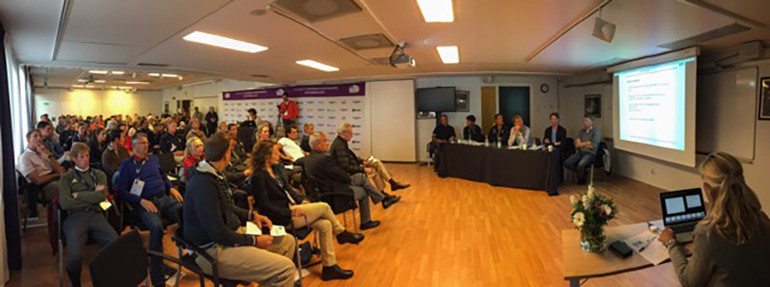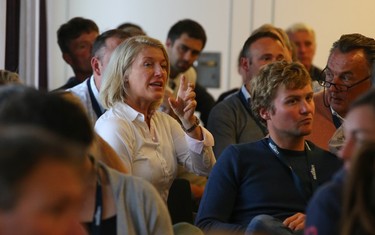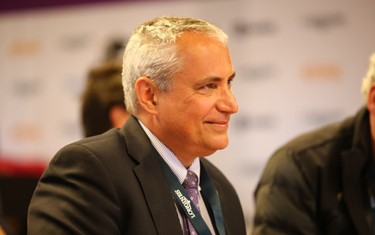The International Jumping Riders Club (IJRC) held its 2017 General Assembly in Gothenburg, Sweden, during the Longines FEI European Championships. On the agenda were important issues, such as proposals about ranking points, the so-called ”blood rule”, CSI/CSIO requirements and hind boots-regulations.
IJRC Vice President Ludger Beerbaum addressed many of the issues personally: “We would really like to underline that it is our intention – and number one priority – to support the heart of our sport: The Nations Cup series, and the future of it,” he said. “Being an Olympic sport, we have to really pay attention that we continue in the right way – having in mind the Olympic spirit and agenda. It is in our interest to support this. We have had a lot of discussion in the past, about formats, about the number of the riders – and I think once again if you experienced the last days here in Gothenburg, it was something nobody should miss. It was something really, really special and has proved again that the countries fighting together, against each other, is something really special and should be kept a priority in our sport.”
When it came to the invitation system and ranking points, IJRC has worked on a proposal, where Longines Ranking points would only be distributed at events that respect the invitation system of 60/20/20 percent. Ludger commented: “It is not easy – we have to be aware, that the ideal is difficult to achieve: We have different circumstances. This year Germany will only have one spot for the World Cup apart from the Top 10, and you know how many riders want to go to these shows? It is really, really difficult. And this ranking point issue, it is an issue: Every four years, according to the ranking, you qualify your nation’s athletes for the Olympic Games. If there is too much flexibility in earning those points, it can end up that you get the wrong athletes qualified for the Olympic Games. Knowing, that this is not easy – it is something we should try to avoid.”
Steve Guerdat, IRJC board member, was all about protecting the real sport and was applauded by his colleagues. “What we want to achieve, is that the Longines Ranking points are distributed at shows that support the sport, not at shows that are only open for the richest riders. It is just to make sure the points are given for the sport, not at rich private parties. That is the goal. We are trying to find a way and a solution to protect the real sport,” he explained about the IJRC’s proposal regarding the distribution of Longines Ranking points.
When it was time to discuss the so-called “blood rule”, Ludger was not afraid to voice his opinion: “I think we should be very honest here: We have implemented the rule, not foreseeing the consequences and what is the outcome. And now we have a disaster. Let’s be honest – this is the case. We don’t make a difference! If your horse overreaches, you come out with a massive bleeding – no disqualification. You come out with a nose bleed – no disqualification. But if you, for whatever reason, voluntary or not voluntary, accident or whatsoever, come out with a scratch – disqualified! What is this? We have implemented a rule, but this is only for side marks – I think we have a problem here.”
In regard to try and correct the issue, Beerbaum highlighted the importance of good communication. “We need very good communication, and explanation to the outside world. This is about well-fair and fair play – fair play for the competition between us, and we should not forget about that.”
Rodrigo Pessoa, second Vice President of the IJRC, asked for a change of terms for the so-called “blood rule”: “Is it possible to change the name of this – from the start, it is just bad. Can we call it something else, a ‘spur rule’ maybe?” he asked the FEI. Instead of a mandatory disqualification, Rodrigo was in favour of giving the rider a yellow card: “It is not minor or major – if there is a scratch, give them a yellow card, with a very short time. If it happens again, then disqualify – they have to take care. Overreach or nose bleed you cannot control, but you can control a spur mark or excess use of whip. We want to be strict about it, but shortly”, he said, explaining that if yellow cards would be given, their time of effect should be kept short, in his opinion for one month.
Austrian rider Max Kühner, a board member of the IJRC, also commented on the proposal: “Maybe we can think about the consequences – it must not automatically lead to elimination,” he said. “Give a yellow card. Like in football, if you have done something wrong – you get a yellow card. If you have a second yellow card, then you can be eliminated. I don’t see the point, why it has to be an elimination straight away. We had some people ride fantastic rounds, winning a class and it was fantastic sport and then they get eliminated – the public does not understand this!”
Max also had an opinion about the multiple show fees when discussing the CSI/CSIO requirements: “We need transparency – you need to know what you need to pay for. There should be no new fees during the weekend,” he said.
For the CSI/CSIO requirements, Ludger commented: “I think the more rules we are bringing, the more confusing it will be. Leave it a free market! If a show is bad and too expensive, next year the people will not come! But if it is a good show, everyone is happy, they have no problem to pay 100 Euros more – even a small show, if it is running good, I think people will go,” he said.
When it came to the CSI/CSIO requirements, Henrik von Eckermann – who is a member of a FEI working group focusing on the subject – said: “It seems that the harmonizing of entry fees, that everyone was so strongly against, will not happen. Instead, we are discussing a possibility of having a set entry fee and what that entry fee should entail.”
Steve tried to put himself in the shoes of the show organizers: “I think we are beating the organizers up – we tell them they don’t bring in enough money, we say we don’t want to pay extra for a facility – we all say no. At the same time, there are some people who pay around 400,000 Euros to ride around 10-12 shows and call this an investment. We give open doors for some to do this, but for others we say we need to restrict the fees?” questioned Guerdat.
Ludger was not worried about the FEI proposal on banning hind boots that are not solely for protective purposes: “If you see the big picture, every weekend, no matter what you ride – Global Champions Tour, Nations Cup, World Cup – there are too many clears, maximum speed in the jump-off. Is it not really time to think about slowing it all down a little? We are too obsessed (about hind boots). I remember Hugo Simon and John Whitaker winning the (World Cup Final) in Gothenburg without back boots – and it was fantastic sport.”
When it came to the hind boots-issue, Kühner said: “For me, we start a discussion about tools and the question is: Where does it end? This is performance enhancing – we start a discussion and we cannot decide where the line is cut.”
Guerdat was realistic about the proposed hind boot regulation: “I think we all need to be aware, that at some point this will happen – hind boots will be gone. There was a sport before the boots; they had a winner, the good riders were good riders and good horses were good horses. Course designers are going to have to change a lot – four planks on flat cups cannot be allowed anymore, time allowed like we had the last days here are not going to go anymore, but I am absolutely sure that the best rider will still be the best rider,” he stated. “We are just going to have to ride better! We have this in our heads, that we cannot ride without back boots – but this is a mistake. We are going to have to ride better, be smarter in the course – but we will see great sport, I am sure. It is good to do it over some time, so everyone has time to get used to it. We also complain all the time that we have too many clears! Everybody complains – we won’t have that anymore.”
The replay of the IJRC General Assembly can be watched here.
Text © World of Showjumping by Nanna Nieminen // Pictures © IJRC













